The Deccan sultanates were five late-medieval Indian kingdoms—on the Deccan Plateau between the Krishna River and the Vindhya Range—that were created from the disintegration of the Bahamani Sultanate and ruled by Muslim dynasties: namely Ahmadnagar, Berar, Bidar, Bijapur, and Golconda. The sultanates had become independent during the break-up of the Bahmani Sultanate. The five sultanates owed their existence to the declaration of independence of Ahmadnagar in 1490, followed by Bijapur and Berar in the same year. Golconda became independent in 1518, and Bidar in 1528.
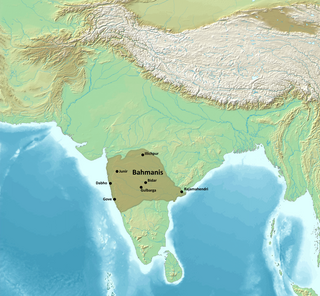
The Bahmani Sultanate was a late medieval Muslim empire that ruled the Deccan Plateau in India. The Bahmani Sultanate came to power in 1347 during the rebellion of Ismail Mukh against Muhammad bin Tughlaq, the Sultan of the Tughlaq dynasty of Delhi. Ismail Mukh then abdicated in favour of Zafar Khan, who would establish the Bahmani Sultanate.

Bidar (/biːd̪ər/) is a city in the north-eastern part of Karnataka state in India. It is the headquarters of Bidar district, which borders Maharashtra and Telangana. It is a rapidly urbanising city in the wider Bidar Metropolitan area. The city is well known for its many sites of architectural, historical and religious importance. Bidar City have a population of more than 2 lakh and are likely to get upgraded to municipal corporation in the next 5 years.

The Adil Shahi or Adilshahi, was a Shia, and later Sunni Muslim, dynasty founded by Yusuf Adil Shah, that ruled the Sultanate of Bijapur, centred on present-day Bijapur district, Karnataka in India, in the Western area of the Deccan region of Southern India from 1489 to 1686. Bijapur had been a province of the Bahmani Sultanate (1347–1518), and member of the Deccan Sultanates, before its political decline in the last quarter of the 15th century and eventual break-up in 1518. The Bijapur Sultanate was fully absorbed into the Mughal Empire on 12 September 1686, after its conquest by the Emperor Aurangzeb.
Ismail Adil Shah was the Sultan of Bijapur who spent most of his time extending his territory. His short-lived reign helped the dynasty establish a stronghold in the Deccan.
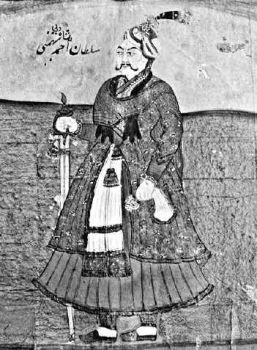
Ahmed Shah Al Wali Bahamani was the ruler of the Bahmani Sultanate from 1 October 1422 to 17 April 1436, and was a great patron of arts and culture. He brought Persian artisans from Iran, including the metal-worker Abdulla-bin-Kaiser, who was the master of Bidriware, the inlaying of zinc alloy with silver and gold.
Qasim Barid I was prime-minister of the Bahmani sultanate and the founder of the Bidar Sultanate, one of the five late medieval Indian kingdoms together known as the Deccan sultanates.

The Sultanate of Ahmednagar or the Nizam Shahi Sultanate was a late medieval Indian Muslim kingdom located in the northwestern Deccan, between the sultanates of Gujarat and Bijapur, ruled by the Nizam Shahi or Bahri dynasty. It was established when Malik Ahmed, the Bahmani governor of Junnar after defeating the Bahmani army led by general Jahangir Khan on 28 May 1490 declared independence and established the Nizam Shahi dynasty of the Sultanate of Ahmednagar.
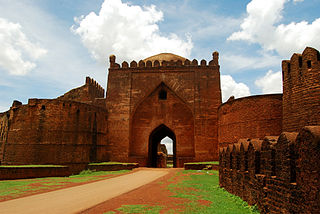
Bidar Fort is located in old city area, Bidar, Karnataka, India. The fort, the city and the district are all affixed with the name Bidar. Sultan Ahmad Shah I of the Bahmanid dynasty shifted his capital from Gulbarga to Bidar in 1427 and built his fort along with a number of Islamic monuments. There are over 30 monuments inside Bidar fort.
Bidar is a historic place located in the north-eastern part of the South Indian state of Karnataka. Bidar enjoys a picturesque situation, having been situated and built on the brink of a plateau, and thus commanding lovely views of the lowlands (talghat) towards the north and the east. Its latitude is 17°55'N., its longitude 77°32' E., and the height above the sea-level 2,330 feet (710 m). The climate is bracing and the temperature in the hottest season does not usually rise above 105 °F (41 °C). The Bidar plateau is an irregular oblong, 22 miles (35 km) in length and 12 miles (19 km) in extreme breadth.

Deccani architecture, particularly the architecture of the Bahmani and Deccan Sultanates, is the architecture of the Deccan Plateau, and is a regional variant of Indo-Islamic architecture. It was influenced by the styles of the Delhi Sultanate and later Mughal architecture, but sometimes also influenced from Persia and Central Asia. Hindu temple architecture in the same areas had very different styles.

Ali Barid Shah I was the third ruler of the Barid Shahi dynasty at Bidar. He succeeded his father in 1540, and ruled until his death in 1580. He was considered a man of letters, and invited scholars and craftsmen from all over the Indian subcontinent to his capital. He is also known to have played a key logistical role in the Battle of Talikota.
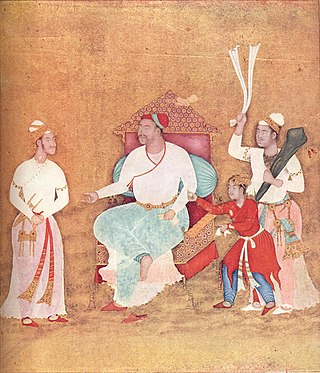
The Deccanis or Deccani people are an Indo-Aryan ethno-religious community of Deccani-speaking Muslims who inhabit or are from the Deccan region of Western and Southern India. The community traces its origins to the shifting of the Delhi Sultanate's capital from Delhi to Daulatabad in 1327 during the reign of Muhammad bin Tughluq. Further ancestry can also be traced from immigrant Muslims referred to as Afaqis, also known as Pardesis who came from Central Asia, Iraq and Iran and had settled in the Deccan region during the Bahmani Sultanate (1347). The migration of Muslim Hindavi-speaking people to the Deccan and intermarriage with the local Hindus whom converted to Islam, led to the creation of a new community of Hindustani-speaking Muslims, known as the Deccani, who would come to play an important role in the politics of the Deccan. Their language, Deccani, emerged as a language of linguistic prestige and culture during the Bahmani Sultanate, further evolving in the Deccan Sultanates.
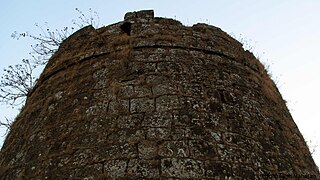
Fathullah Imad-ul-mulk was the founder of the Imad Shahi Dynasty and the Berar Sultanate. Originally a Hindu captive from Vijayanagara, Fathullah was brought up as a Deccani Muslim and rose to command the army of Berar under the Bahmani Sultanate. In 1490, he declared himself Sultan of Berar, which he ruled until his death in 1504. He was succeeded by his son Aladdin Imad Shah.
Mahmood Shah or Shihab-Ud-Din Mahmud was the sultan of the Bahmani Sultanate from 1482 until his death in 1518. His long rule is noted for the disintegration of the sultanate and the creation of the independent Deccan sultanates.

The Barid Shahi tombs are tombs of the Barid Shahi dynasty. They are located in Bidar in the Indian state of Karnataka.
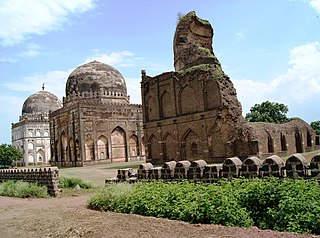
The Bahmani tombs complex at Bidar is the necropolis of the Bahmani dynasty, located in Bidar, in the Indian state of Karnataka.
Amir Barid I, also known as Amir Ali Barid was the second ruling member of the Barid Shahi dynasty.
Alauddin Humayun Shah Bahmani was the sultan of the Bahmani Sultanate, who reigned between 1458 and 1461. Also known as Humayun Shah Zalim, he is described as a cruel ruler, known for executing people in torturous ways.

The Wars of the Deccan Sultanates were a prolonged period of military conflict lasting from 1495 to 1678 This series of battles pitted the rival powers of the Deccan Sultanates against the Vijayanagara Empire. Over the course of approximately 120 years, these two entities engaged in a series of wars and skirmishes that were marked by significant displays of military strength and strategic maneuvering.




















